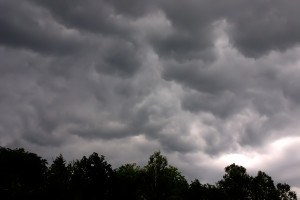

Wichita, Kansas, storm chaser Jim Reed was leaving a Chick-fil-A last week when he was stopped by an elderly couple.
“Are you the severe weather man?” one asked, seeing his specially marked chase vehicle.
They asked about the coming rain and thanked him for being aware of threatening weather and helping to warn the public.
“It’s another example of people appreciating what we do,” Reed said, a sense of wonderment in his voice.
 Reed and other storm chasers and weather researchers said they have noticed a distinct increase in compliments and praise in the aftermath of the massive El Reno tornado, which killed eight people – including four storm chasers – in the Oklahoma City metropolitan area May 31. Another 12 people died in flash flooding triggered by the heavy rain from the thunderstorms that spawned the tornado outbreak that day, The Wichita Eagle reported.
Reed and other storm chasers and weather researchers said they have noticed a distinct increase in compliments and praise in the aftermath of the massive El Reno tornado, which killed eight people – including four storm chasers – in the Oklahoma City metropolitan area May 31. Another 12 people died in flash flooding triggered by the heavy rain from the thunderstorms that spawned the tornado outbreak that day, The Wichita Eagle reported.
A burst of criticism for storm chasers followed the deadly day, but Josh Wurman, founder of the Center for Severe Weather Research in Boulder, Colo., said that was not a typical reaction.
His general experience both before and after El Reno, he said, has been exactly the opposite of the criticism leveled by some after that deadly tornado.
“People have almost been overly respectful – worshipful,” Wurman said. “It’s, ‘Oh, thank you for what you’re doing. You’re our heroes.”‘
Wurman was heavily involved in the Vortex 2 project that conducted field research of tornadoes and thunderstorms capable of producing tornadoes. He now has a fleet of portable radar, known as Doppler on Wheels, that has been used to track and gather severe weather of various types.
Wherever he’s gone – whether it’s to Louisiana to track hurricanes or the mountains to study fire weather or to the northeastern U.S. to study lake-effect snow – “it’s perceived as really useful,” Wurman said.
Mike Smith, senior vice president for AccuWeather, said he was really bothered by the scorn for storm chasers that was voiced after the El Reno tornado.
He addressed what he considers to be a lack of respect for weather research in a recent speech to the Downtown Rotary in Wichita.
“Why is it that meteorological research, which clearly has led to thousands of lives saved every year, why doesn’t it get the respect that it is due?” Smith asked.
Three of the four chasers who died – Tim Samaras, his son Paul and his chase partner Carl Young – were gathering data by deploying probes in the path of the massive tornado. Friends and colleagues speculate that the researchers were unable to find an escape route in time when the tornado changed direction and grew dramatically in size and speed.
Richard Charles Henderson, who, according to the Daily Oklahoman, was an amateur out “having fun,” was the fourth chaser killed that day.
Valley Center storm chaser Brandon Ivey said it is not easy to spell out which piece of research led to changes in forecasting or development of new technologies that helps save lives, which may be why some do not recognize its value.
“It’s amazing how much weather forecasting has come along since the 1970s,” Ivey said.
Ivey and his chase partner Sean Casey drew criticism for shooting IMAX video of a large tornado as it struck their Tornado Intercept Vehicle on Memorial Day in Smith County, Kan. While Casey wants to use it in a new movie for IMAX theaters, it is also being sent to the Center for Severe Weather Research for analysis.
“That may be our contribution to science – if they can better understand what’s going on inside a large tornado,” Ivey said.
Ivey gathered scientific data from instruments on the TIV until the tornado – nearly a mile wide at times – tore the instruments from the vehicle’s exterior.
Wurman said he understands why there might be some public scorn for storm chasers who clog the highways on stormy days because he figures more than 99 percent of them are “recreational” and offer little in terms of improving public safety.
“For recreational chasers, there’s no real public benefits for what they do,” Wurman said. “Mostly, they’re calling in ground truth that’s already known. If you’re the 100th person that calls in a tornado, what good does that do?”
That’s not to denigrate recreational chasing, Wurman said.
“I think people should chase” for the fun of it, he said. “I think it’s a great thing. I wish the discussion was a little bit more honest” about why they’re doing it.
Yet Ivey said it doesn’t bother him that numerous chasers may end up shooting video of the same tornado. Researchers may glean something important from being able to view the same storm from various angles or viewpoints.
Storm chaser and weather researcher Jon Davies said a recent best-selling book could be educating the public on the value of weather research. Nate Silver’s “The Signal and the Noise: Why So Many Predictions Fail – but Some Don’t” includes a chapter on how weather forecasting has improved significantly over the past 30 years due to research and proper implementation of findings.
The evolution of forecasting, Davies said, is “a real glowing example of doing statistical research and using it to really improve something.”